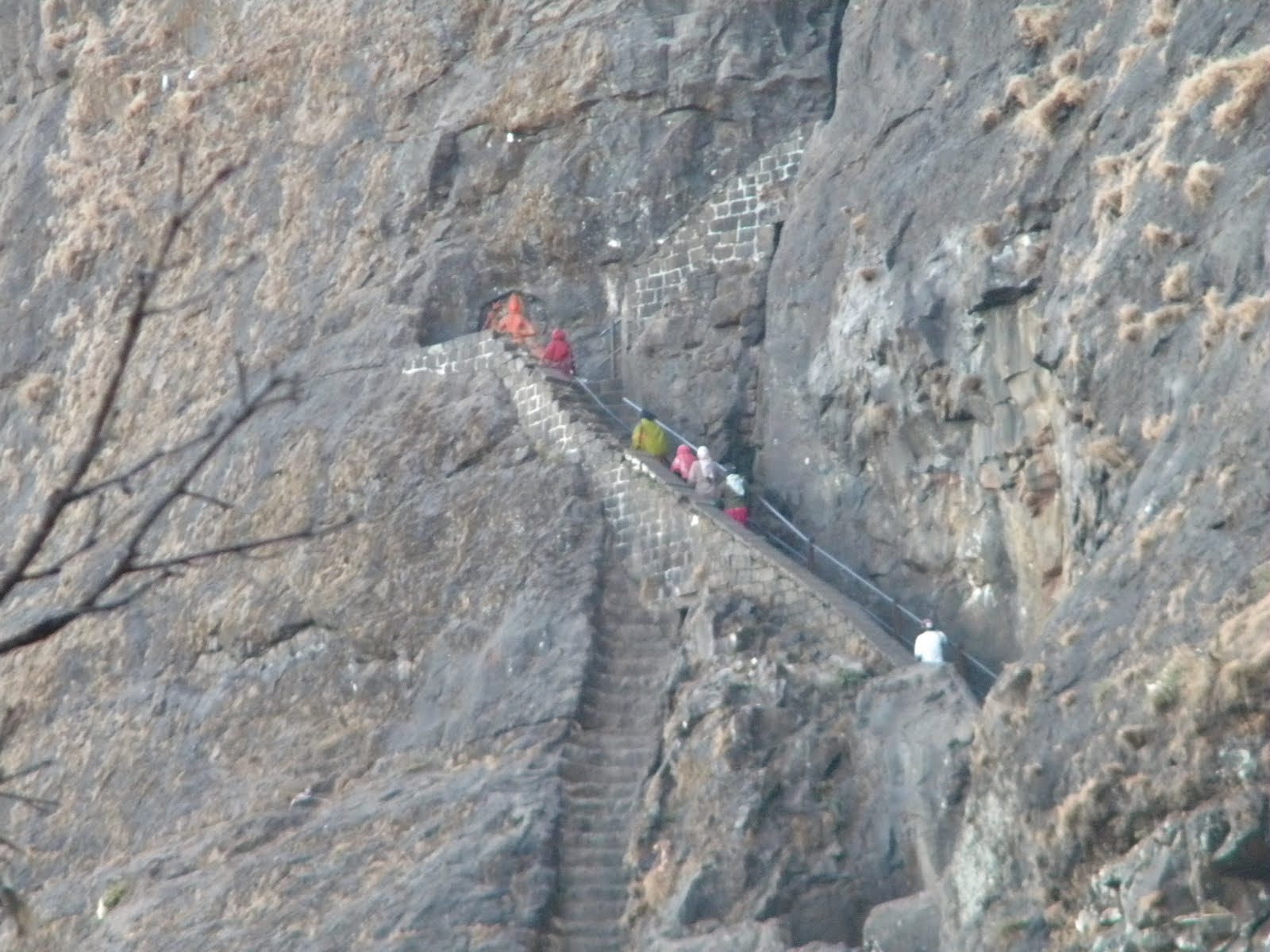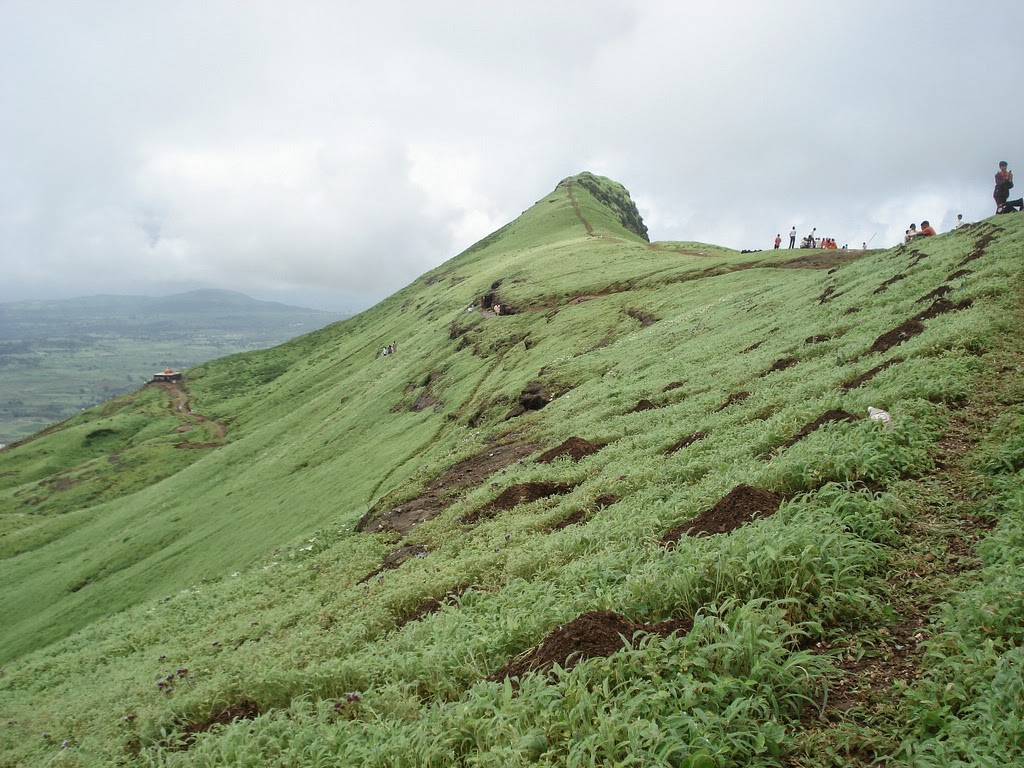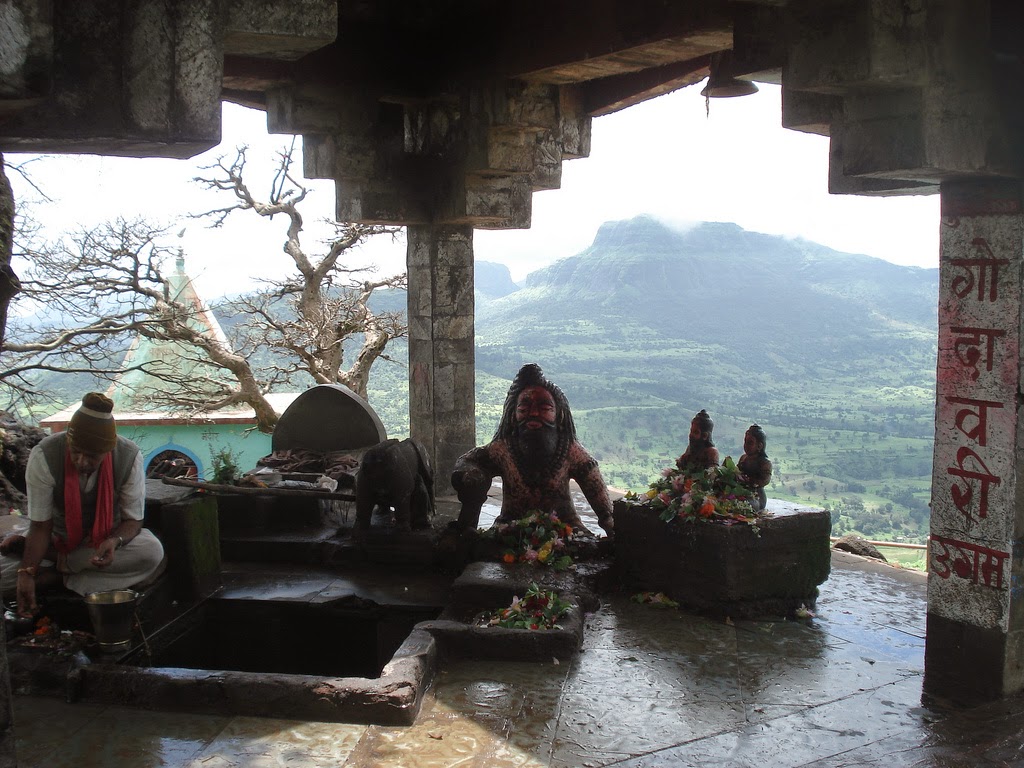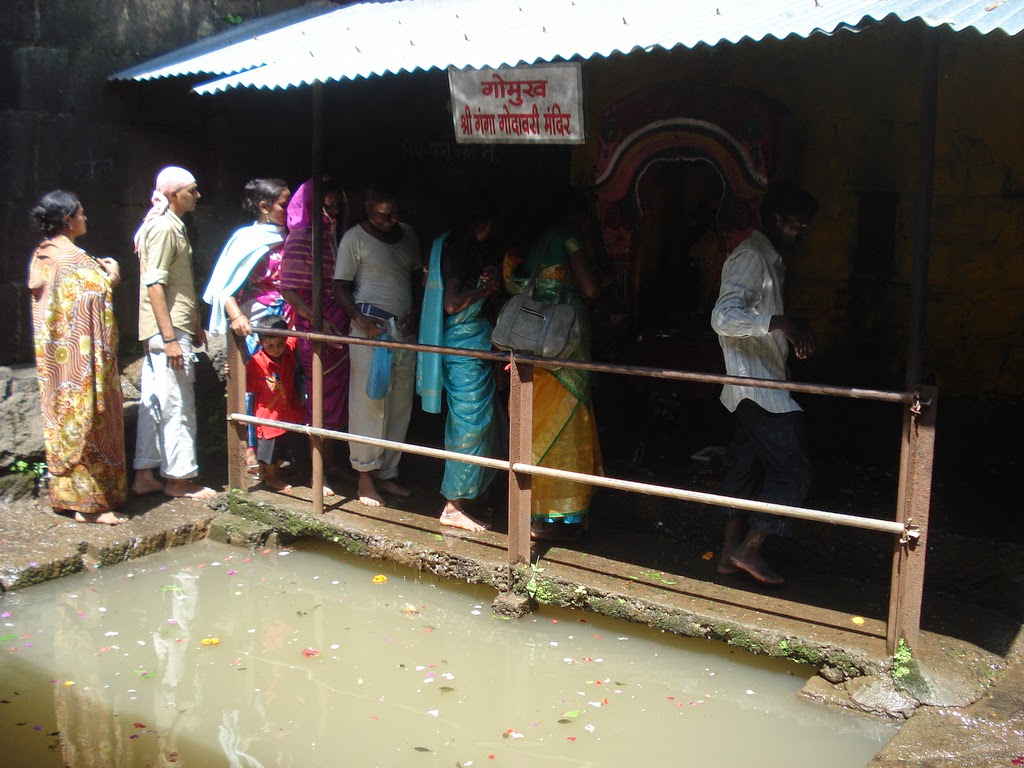The 24rd episode of Sri Ramanin Padhayil began with the below verses:
Who happen to hear the story of Rama,
Composed by the lion among poets Valmiki,
Who always lived in the forest.
Sri Rama left Chitrakoot to visit the hermitages of prominent sages like Sharbhanga, Suteeksha, Agastya etc. All these hermitages are covered in our previous articles. Later we all reached a place called Ramtek. After visiting Ramtek, we all left to Nashik, located on the banks of River Godavari and now we are in Nashik.

Ramkund is a religiously significant place for hindus as legend says that, lord Sri Rama is believed to have performed holy bath & gave tharpan to ancestors during his travel along the "Dandakaraya" along with Sita & Lakhsmana.

The Kalaram temple is an old Hindu shrine dedicated to lord Rama in the Panchavati area of Nasik city in Maharashtra, India. It is probably the most important Hindu shrine in the city. The temple derives its name from the statue of Lord Rama that is black. The literal translation of kalaram means black Rama.

This famous temple is just next to the Kale Ram mandir. The Lord here is as white as the Kala Ram Lord is black. It is a smaller temple with beautiful small white marble idols of Rama, Lakshmana & Sita. There is a also a hanuman sannidhi.

Just adjacent to KalaRam Temple is the Sita Cave, the cave which is believed to be where Devi Sita was stayed to hide herself from Demons.

Outside the cave is a large grove of 5 very old Banyan trees, after which the area is named, Panchvati. There is a museum depicting incidents in Ramayana.

Tapovan is popular for its prominence in the epic Ramayan. It is believed that Lakshman had cut Surpanakha's nose at this place which is how the city got its name Nasik (Nashik).
Birth of River Godavari: Part of the water of the Ganga that got stuck in Shiva's hair was brought down to earth by Bhagiratha. The remaining part was brought down by the sage Gautama. Parvati was married to Shiva, but Shiva seemed to be fonder of Ganga than of Parvati. Parvati resolved that a way had to be found to remove Ganga from Shiva's hair. She tried persuasion, but Shiva refused to listen. At this time, there was a terrible drought on earth which went on for fourteen years. The only place that was not affected by the drought was the sage Gautama's hermitage.
Varuna - the God of Rains, pleased with Sage Gautama arranged rains every day in Gautama's Ashram (dwelling place) which was in Trimbakeshwar. Gautama used to sow rice in the surrounding fields of his Ashram in the morning, reap the crop in the afternoon and with it fed a large group of rishis, who took shelter in his Ashram on account of the famine. The blessings of the group of rishis increased the merit (Punya) of Gautama. Lord Indra's position became shaky because of his increased merit. So Indra ordered clouds to rain all over Trimbakeshwar, so that the famine will be over and Rishis will go back and the increasing merits of Gautama will be weakened. Although the famine was over, Gautama urged the Rishis to stay back and kept on feeding them and gaining merit. Once he saw a cow grazing in the paddy field and he drove her away by throwing Darbha (sharp, pointed grass). The slender cow died by this. It was Jaya - Parvati's friend, who had taken the form of a cow. This news upset the Rishis and they refused to luncheon at his Ashram. Gautama requested Rishis to show a way out of this sin. He was advised to approach Lord Shiva and request him to release Ganges and a bath in the Ganges would set him free of his sins. Gautama then practiced penance by going to the peak of Brahmagiri. Lord Shankara was pleased by his worships and gave him the Ganges. Shiva extremely pleased and appeared before Gautama with his Ganas and offered the sage a boon. All that the sage asked for was relief off his sin. Shiva explained that the sage was innocent and explained the situation to him. But the sage told him that in the eyes of the world he was still a sinner so he wanted to atone for that and requested that River Ganga be brought to him so that he can purify himself. Sage Gautama humbly said that the other Rishis had not done any wrong to him because in fact they became the reason for him to see Lord Shiva.
However, Ganges was not prepared to part with Lord Shiva, which irritated him. He made TandavNrutya (dance) on the peak of Brahmagiri and dashed his jata there. Frightened by this action, Ganges appeared on Brahmagiri. This place is known as Godavari udgam seen at the top of the Hill.

































Below is the verse from Ramayana Aranya Kandam in which Sita prays to Godavari river to please tell Rama that Ravana is taking her:
"No one in this whole world is guilty of as many misdeeds as I am, O Laksmana: and that is why I am being visited by sorrow upon sorrow, grief upon grief, breaking my heart and dementing me.
I lost my kingdom, and I was torn away from my relations and friends.
I got reconciled to this misfortune.
But then I lost my father.
I was separated from my mother.
Coming to this hermitage, I was getting reconciled to that misfortune.
But I could not remain at peace with myself for long.
Now this terrible misfortune, the worst of all, has visited me.
Alas, how bitterly Sita would have cried while she was carried away by some demon.
May be she was injured; may he her lovely body was covered with blood.
Why is it that when she was subjected to such suffering, my body did not split into pieces?
I fear that the demon must have cut open Sita's neck and drunk her blood.
How terribly she must have suffered when she was dragged by the demons.
Laksmana, this river Godavari was her favourite resort.
Do you remember how she used to come and sitting on this slab of stone talk to us and laugh?
Probably she came to the river Godavari in order to gather lotuses?
But, no: she would never go alone to these places.
O sun!
You know what people do and what people do not do.
You know what is true and what is false.
You are a witness to all these.
Pray, tell me, where has my beloved Sita gone.
I have been robbed of everything by this grief.
O wind!
You know everything in this world, for you are everywhere.
Pray, tell me, in which direction did Sita go?"
Rama said:
"See, Laksmana, if Sita is somewhere near the river Godavari."
Laksmana came back and reported that he could not find her.
Rama himself went to the river and asked the river:
"O Godavari, pray tell me, where has my beloved Sita gone?"
But the river did not reply.
It was as if, afraid of the anger of Ravana, Godavari kept silent.
Rama was disappointed.
He asked the deer and the other animals of the forest:
"Where is Sita?
Pray, tell me in which direction has Sita been taken away."
He then observed the deer and the animals; all of them turned southwards and some of them even moved southwards.
Rama then said to Laksmana:
"O Laksmana, see, they are all indicating that Sita has been taken in a southerly direction."
Godavari was scared to Ravanan and didn't speak anything to Rama. Godavari didn't do this service to Rama/Sita, so can we all pray to Godavari?
Swami Desikan praises Goda by pointing out that whatever greatness the Godavari river possesses, is because it assumed the name of Goda as part of its name. The purana's say that even rivers like Ganga become purified by their association with Godavari. Such is the fame of Godavari river, all because of its bearing the name of Goda. In fact, if anything, Godavari had incurred the great sin of indirectly helping Ravana, by keeping silent when Rama asked Godavari about the whereabouts of Sita who
had been abducted by Ravana. In spite of Sita specifically instructing Godavari to inform Rama and Lakshmana that Ravana has abducted her, Godavari kept quiet because of the fear of Ravana. All that sin was washed away, and Godavari became famous, after the birth of Goda, because of the association of the name of Goda with Godavari's name. While Ganga purifies itself by its association with Godavari, Godavari gets its fame only because of its association with the name of Goda (Andal).
This is the place where the Godavari river begins known as Godavari Udgam located on the top of Brahmagiri Hill. However, Ganges was not prepared to part with Lord Shiva, which irritated him. He made TandavNrutya (dance) on the peak of Brahmagiri and dashed his jata there. Frightened by this action, Ganges appeared on Brahmagiri. Later on Ganges appeared in the Trimbak Tirtha. Gautama praised her but she off and on appeared on the mountain at various places and disappeared in anger. Gautama could not bathe in her waters. Ganges then appeared in Gangadwar, Varaha-tirtha, Rama-Laxman tirtha, Ganga Sagar tirtha. Still Gautama could not bathe in her waters. The Gautama surrounded the river with enchanted grass and put a vow to her. The flow stopped there and the tirtha thus came to be called Kushavarta. It is from this Kushavarta that the river Godavari flows up to the sea. The sin of killing a cow by Gautama was wiped off here.










Such is the story and greatness of this place called "Godavari Udgam" - the starting place of river Godavari. One just need to wish to come here and no need to spend huge amount of money. This place is full of lush green scene and also lot of punya (merit). Wishing all of us to go and visit this place. Now let us go inside Nasik Panchavati to see other interesting places.
Kujantam rama rameti madhuram madhuraaksharam
aaruhya kavitaa saakhaam vande valmiki kokilam
Valmike muni simhasya kavitha vana charina,
Srunvan Rama kadha naadam ko na yathi paraam gathim
Who happen to hear the story of Rama,
Composed by the lion among poets Valmiki,
Who always lived in the forest.
Sri Rama left Chitrakoot to visit the hermitages of prominent sages like Sharbhanga, Suteeksha, Agastya etc. All these hermitages are covered in our previous articles. Later we all reached a place called Ramtek. After visiting Ramtek, we all left to Nashik, located on the banks of River Godavari and now we are in Nashik.
Nasik Parikrama:
Let us go through all the places in and around Nashik in brief for now and later in detail in our upcoming articles. At the same place Lakshmana, cut off the nose of Surpanakha and thus this place was named as "Nasik" (in Sanskrit Nasika means nose).Ram Kund

Ramkund is a religiously significant place for hindus as legend says that, lord Sri Rama is believed to have performed holy bath & gave tharpan to ancestors during his travel along the "Dandakaraya" along with Sita & Lakhsmana.
Kalaram Temple

The Kalaram temple is an old Hindu shrine dedicated to lord Rama in the Panchavati area of Nasik city in Maharashtra, India. It is probably the most important Hindu shrine in the city. The temple derives its name from the statue of Lord Rama that is black. The literal translation of kalaram means black Rama.
Gore Ram Temple

This famous temple is just next to the Kale Ram mandir. The Lord here is as white as the Kala Ram Lord is black. It is a smaller temple with beautiful small white marble idols of Rama, Lakshmana & Sita. There is a also a hanuman sannidhi.
Sita Gumpha Caves

Just adjacent to KalaRam Temple is the Sita Cave, the cave which is believed to be where Devi Sita was stayed to hide herself from Demons.
Panchvati

Outside the cave is a large grove of 5 very old Banyan trees, after which the area is named, Panchvati. There is a museum depicting incidents in Ramayana.
Tapovan

Tapovan is popular for its prominence in the epic Ramayan. It is believed that Lakshman had cut Surpanakha's nose at this place which is how the city got its name Nasik (Nashik).
Brahmagiri Hill, Trimbakeshwar:
Before seeing all the places above one by one, let us go to a place called Brahmagiri located 35 Kms from Nashik. In the village Trimbak, Trimbakeshwar temple is a famous pilgrim place. Trimbakeshwar is also the origin of river Godavari. The source of the Godavari River is situated near Trimbak in Nashik District of Maharashtra. After setting off, the river runs towards the east, traversing the Deccan Plateau. In the end, the river empties into the Bay of Bengal at Narasapuram in West Godavari district, Andhra Pradesh. The second largest river in India, Godavari is often referred to as the Vriddh (Old) Ganga or the Dakshin (South) Ganga. We couldn't cover this place during our Sri Rama Anu Yatra held in 2006 & 2010.Birth of River Godavari: Part of the water of the Ganga that got stuck in Shiva's hair was brought down to earth by Bhagiratha. The remaining part was brought down by the sage Gautama. Parvati was married to Shiva, but Shiva seemed to be fonder of Ganga than of Parvati. Parvati resolved that a way had to be found to remove Ganga from Shiva's hair. She tried persuasion, but Shiva refused to listen. At this time, there was a terrible drought on earth which went on for fourteen years. The only place that was not affected by the drought was the sage Gautama's hermitage.
Varuna - the God of Rains, pleased with Sage Gautama arranged rains every day in Gautama's Ashram (dwelling place) which was in Trimbakeshwar. Gautama used to sow rice in the surrounding fields of his Ashram in the morning, reap the crop in the afternoon and with it fed a large group of rishis, who took shelter in his Ashram on account of the famine. The blessings of the group of rishis increased the merit (Punya) of Gautama. Lord Indra's position became shaky because of his increased merit. So Indra ordered clouds to rain all over Trimbakeshwar, so that the famine will be over and Rishis will go back and the increasing merits of Gautama will be weakened. Although the famine was over, Gautama urged the Rishis to stay back and kept on feeding them and gaining merit. Once he saw a cow grazing in the paddy field and he drove her away by throwing Darbha (sharp, pointed grass). The slender cow died by this. It was Jaya - Parvati's friend, who had taken the form of a cow. This news upset the Rishis and they refused to luncheon at his Ashram. Gautama requested Rishis to show a way out of this sin. He was advised to approach Lord Shiva and request him to release Ganges and a bath in the Ganges would set him free of his sins. Gautama then practiced penance by going to the peak of Brahmagiri. Lord Shankara was pleased by his worships and gave him the Ganges. Shiva extremely pleased and appeared before Gautama with his Ganas and offered the sage a boon. All that the sage asked for was relief off his sin. Shiva explained that the sage was innocent and explained the situation to him. But the sage told him that in the eyes of the world he was still a sinner so he wanted to atone for that and requested that River Ganga be brought to him so that he can purify himself. Sage Gautama humbly said that the other Rishis had not done any wrong to him because in fact they became the reason for him to see Lord Shiva.
However, Ganges was not prepared to part with Lord Shiva, which irritated him. He made TandavNrutya (dance) on the peak of Brahmagiri and dashed his jata there. Frightened by this action, Ganges appeared on Brahmagiri. This place is known as Godavari udgam seen at the top of the Hill.

























Below is the verse from Ramayana Aranya Kandam in which Sita prays to Godavari river to please tell Rama that Ravana is taking her:
hamsakarandavakirnam vande godavarim nadim
kshipram ramaya Samsa tvam sitam harati ravanah
"No one in this whole world is guilty of as many misdeeds as I am, O Laksmana: and that is why I am being visited by sorrow upon sorrow, grief upon grief, breaking my heart and dementing me.
I lost my kingdom, and I was torn away from my relations and friends.
I got reconciled to this misfortune.
But then I lost my father.
I was separated from my mother.
Coming to this hermitage, I was getting reconciled to that misfortune.
But I could not remain at peace with myself for long.
Now this terrible misfortune, the worst of all, has visited me.
Alas, how bitterly Sita would have cried while she was carried away by some demon.
May be she was injured; may he her lovely body was covered with blood.
Why is it that when she was subjected to such suffering, my body did not split into pieces?
I fear that the demon must have cut open Sita's neck and drunk her blood.
How terribly she must have suffered when she was dragged by the demons.
Laksmana, this river Godavari was her favourite resort.
Do you remember how she used to come and sitting on this slab of stone talk to us and laugh?
Probably she came to the river Godavari in order to gather lotuses?
But, no: she would never go alone to these places.
O sun!
You know what people do and what people do not do.
You know what is true and what is false.
You are a witness to all these.
Pray, tell me, where has my beloved Sita gone.
I have been robbed of everything by this grief.
O wind!
You know everything in this world, for you are everywhere.
Pray, tell me, in which direction did Sita go?"
Rama said:
"See, Laksmana, if Sita is somewhere near the river Godavari."
Laksmana came back and reported that he could not find her.
Rama himself went to the river and asked the river:
"O Godavari, pray tell me, where has my beloved Sita gone?"
But the river did not reply.
It was as if, afraid of the anger of Ravana, Godavari kept silent.
Rama was disappointed.
He asked the deer and the other animals of the forest:
"Where is Sita?
Pray, tell me in which direction has Sita been taken away."
He then observed the deer and the animals; all of them turned southwards and some of them even moved southwards.
Rama then said to Laksmana:
"O Laksmana, see, they are all indicating that Sita has been taken in a southerly direction."
Godavari was scared to Ravanan and didn't speak anything to Rama. Godavari didn't do this service to Rama/Sita, so can we all pray to Godavari?
Swami Desikan praises Goda by pointing out that whatever greatness the Godavari river possesses, is because it assumed the name of Goda as part of its name. The purana's say that even rivers like Ganga become purified by their association with Godavari. Such is the fame of Godavari river, all because of its bearing the name of Goda. In fact, if anything, Godavari had incurred the great sin of indirectly helping Ravana, by keeping silent when Rama asked Godavari about the whereabouts of Sita who
had been abducted by Ravana. In spite of Sita specifically instructing Godavari to inform Rama and Lakshmana that Ravana has abducted her, Godavari kept quiet because of the fear of Ravana. All that sin was washed away, and Godavari became famous, after the birth of Goda, because of the association of the name of Goda with Godavari's name. While Ganga purifies itself by its association with Godavari, Godavari gets its fame only because of its association with the name of Goda (Andal).
This is the place where the Godavari river begins known as Godavari Udgam located on the top of Brahmagiri Hill. However, Ganges was not prepared to part with Lord Shiva, which irritated him. He made TandavNrutya (dance) on the peak of Brahmagiri and dashed his jata there. Frightened by this action, Ganges appeared on Brahmagiri. Later on Ganges appeared in the Trimbak Tirtha. Gautama praised her but she off and on appeared on the mountain at various places and disappeared in anger. Gautama could not bathe in her waters. Ganges then appeared in Gangadwar, Varaha-tirtha, Rama-Laxman tirtha, Ganga Sagar tirtha. Still Gautama could not bathe in her waters. The Gautama surrounded the river with enchanted grass and put a vow to her. The flow stopped there and the tirtha thus came to be called Kushavarta. It is from this Kushavarta that the river Godavari flows up to the sea. The sin of killing a cow by Gautama was wiped off here.







Such is the story and greatness of this place called "Godavari Udgam" - the starting place of river Godavari. One just need to wish to come here and no need to spend huge amount of money. This place is full of lush green scene and also lot of punya (merit). Wishing all of us to go and visit this place. Now let us go inside Nasik Panchavati to see other interesting places.




0 comments:
Post a Comment